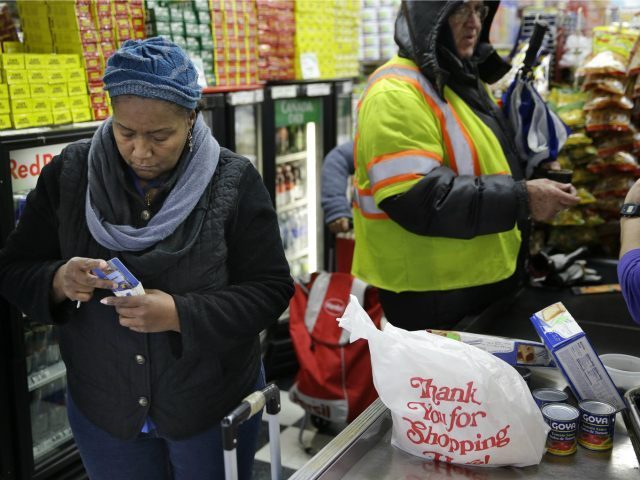Enrollment in the food stamp program plunged by more than 1.3 million since Trump’s inauguration month, according to the latest data from the U.S. Department of Agriculture (USDA).
The USDA data reveals that the number of Supplemental Nutrition Assistance Program (SNAP) participants fell from 42,676,312 in January 2017 when Trump took office to 41,324,904 in December 2017—a decrease of 1,351,408.
Although enrollment in SNAP sharply increased by 3.5 million during the first month of fiscal year (FY) 2018 (October 2017) due to temporary SNAP enrollment in hurricane-affected states, the data shows that enrollment in the food stamp program has declined on the whole over the first calendar year of Trump’s presidency.
The most recent data of food stamp participation available reveals that from November 2017 to December 2017, 333,984 people discontinued their participation in SNAP.
The number of people dropping off the food stamp rolls is a continuation of a bigger trend that has been taking place since 2013.
Food stamp enrollment steadily declined after 2013, when participation in the government program swelled to 47.6 million—the highest amount it has ever been since former President Lyndon Johnson authorized the creation of the food stamp program in 1964. Taxpayers spent $79.8 million on SNAP when enrollment reached its peak in 2013.
After 2013, enrollment in SNAP declined as states passed laws requiring food stamp recipients to work, volunteer, be in school, or take part in job training for a set number of hours a week to receive food stamps. The improving economy also contributed to the continuing decline in food stamp usage.
President Trump has mentioned that he wanted to make it a priority to keep SNAP program costs down at the state and federal levels, which might drive down enrollment even further in 2018.
The USDA announced a proposal last month that the agency says might make Trump’s proposal to curb SNAP costs at the state and federal levels a reality. The agency proposed a “Blue Apron-style” food stamp program that would deliver shelf-stable food—such as cereal boxes, pasta, and canned produce—to food stamp recipients once a month.
The “Harvest Boxes” would make up half of recipients’ allotted benefits for the month while the other half would consist of SNAP benefits on electronic benefit transfer (EBT) cards. The agency clarified that states in charge of delivering the boxes would take recipients’ dietary and religious preferences into account when selecting the type of food for the boxes.
Public support for the USDA’s “Harvest Box” program remains high—a poll conducted in February showed that nearly half of Americans support the Trump administration’s change to the food stamp program.

COMMENTS
Please let us know if you're having issues with commenting.